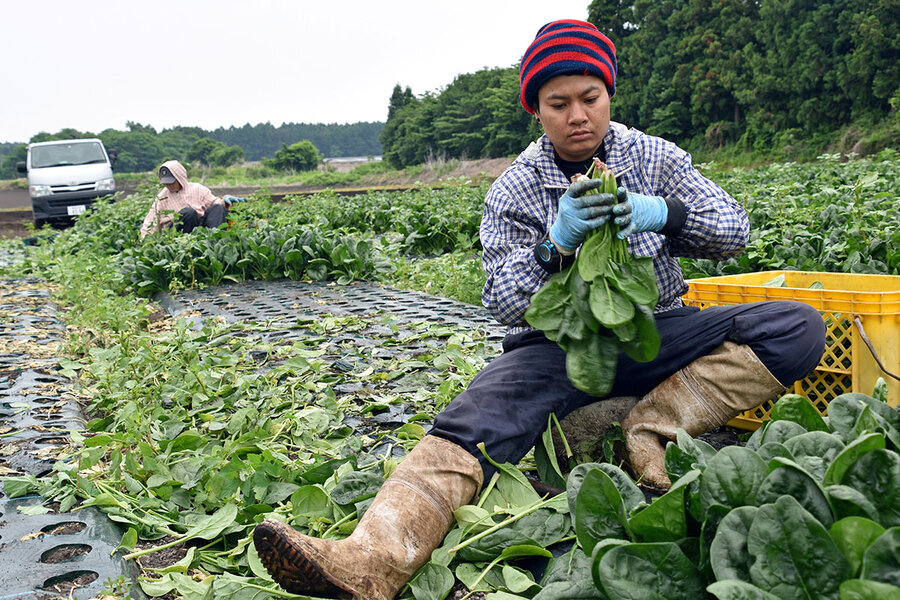Japan’s conundrum: It needs foreign workers. It doesn’t want immigrants.
Loading...
| Tokyo
Fewer babies. More retirees. A shrinking population. That may sound like a list of reasons to boost immigration – but in Japan, it’s a hard sell.
Just 2% of people in Japan are foreigners, and ideas of cultural belonging are tightly tied to Japanese ethnicity. Politicians are loath to look as if they’re opening the door to more immigration, even as short-term foreign workers become more crucial to the economy.
Why We Wrote This
Can you import workers without changing the social fabric? Japan keeps trying to square that circle. But the door may be opening – ever so slightly – to changes that could benefit newcomers and native-born Japanese alike.
About 20% are here as part of a technical intern training program, created to provide training to workers from developing economies. But much of their work is mind-numbing – tasks Japanese workers don’t want to do – and often skills don’t translate back home. Worse, workers’ advocates say, is how few protections trainees have on the job. A government inspection office visited nearly 6,000 employers who accepted trainees, and found more than 4,200 violations.
Is that poised to change? A new policy attempts to correct for some of the abuses, and Prime Minister Abe Shinzo backs a plan that would help some workers to become permanent residents.
Politician Keisuke Tsumura says the Japan of 10 years into the future will look very different.
“Japan will be more globalized,” Mr. Tsumura says, and its growth is limited if it “continues to stay homogeneous.”
When it comes to foreign workers, Japan has a reputation to overcome.
Shi Jianhua has firsthand experience. In 2015, she migrated from China to Japan in search of life-transforming wages. “The agency told me going abroad for three years would change the economic situation of my family,” Ms. Shi says.
Back home in mountainous Hubei province, her husband worked in construction, and after the couple added a second child, expenses had begun to pile up. Ms. Shi’s plans to migrate had been methodical. She’d shelled out RMB 50,000 ($7,300) for Japanese language training, plus another RMB 38,000 ($5,500) in fees to a placement agency to enter Japan’s technical intern training program, created by the Japanese government to provide training and skills to workers from developing economies.
Why We Wrote This
Can you import workers without changing the social fabric? Japan keeps trying to square that circle. But the door may be opening – ever so slightly – to changes that could benefit newcomers and native-born Japanese alike.
Once Ms. Shi landed at a quality control job at a Fuji City paper mill, the mirage quickly revealed itself. Her Japanese supervisor was verbally abusive and called her “stupid” on a daily basis, she says. Her Japanese co-workers were given overtime hours, while she was passed over. “The friendlier you are, the more they bully you,” Ms. Shi says.
Soon enough, it became clear she would earn less than half of the 200,000 monthly yen ($1,850) she says she was promised.
“I felt totally desperate,” says Ms. Shi. Eventually, she attempted suicide, fracturing her spine and rendering her unable to work. Ms. Shi now lives in a shelter in Gifu Prefecture, and is working with Zhen Kai, head of a labor union there, to pursue approval to apply for workers’ compensation and a formal apology from the mill.
Ms. Shi’s story is extreme. Yet the same factors that shaped her experience give rise to the everyday indignities – sometimes escalating into abuse – that non-Japanese workers face in Japan, even as they become ever-more essential to the country’s economy. Foreigners compose only about 2% of the population, and ideas of cultural belonging are tightly tied to Japanese ethnicity; the government, meanwhile, offers migrants few protections.
“Sometimes, I see some Japanese talk to overseas workers as if they were second-class citizens,” says Miyawaki Toshiya, an economics professor at Tokuyama University who’s observed similar dynamics in his classroom. “I try ice-breaking exercises to encourage my Japanese students to mix with the foreign students.”
Such scenarios encapsulate a difficult conundrum. Japan is a country that’s rapidly aging, with a workforce that is shrinking in kind. Yet the Japanese have firmly resisted immigration as a salve for an intense labor shortage. What happens, then, when Japan’s economic future depends on rolling out the welcome mat to foreign workers?
‘Immigration policy’? Not so fast.
Nearly 90% of Japanese employers have a hard time finding enough skilled workers, the largest skills gap in the world. In the low-wage sector, a labor shortage persists in industries such as elder care, construction, welding, and food processing. Meanwhile, the number of children born in Japan has declined each of the past four decades.
Enter foreign workers. China has long been the top supplier of labor to Japan, with the number of workers from Vietnam growing at the fastest rates. The majority of workers hail from those two countries, along with the Philippines, Indonesia, Thailand, Cambodia, and Myanmar.
The government intimates that it wants foreign workers, and has cracked the door open further. In April 2019, a new policy became effective that would draw an estimated 350,000 more workers over the next five years, via expanded opportunities in 14 industries, including nursing care, shipbuilding, and food service. It allows up to a five-year stay, with visas renewable annually. In short, this new “specified skills” program expands the trainee program by taking people in more industries, and also makes it easier for certain workers to stay in the country longer.
Yet, Japanese leaders are in the unenviable position of needing to bring in more foreign workers while – bowing to societal pressures – insisting they are “not” adopting a so-called immigration policy, as Prime Minister Abe Shinzo informed parliament last year. Even so, Mr. Abe backs a plan to assist guest workers of certain skill categories to become permanent residents.
At the end of 2018, roughly 308,000 trainees were working in Japan, constituting about 20% of total foreign workers in Japan, with many more expected in the coming years.
Dubious ‘training’: pickles and fish-packing
Once they arrive, many trainees in the technical intern program have found little protection for abuses on the job. Their visas are tied to a single employer, who is allowed to deduct costs such as room and board from salaries. Sometimes, workers face occupational hazards, while other times, pay is lower than what’s promised.
Meanwhile, the number of cases accepted for permanent residency has actually been decreasing, says Ando Makiko, vice secretary of the nongovernmental organization Solidarity Network with Migrants Japan.
The verdict is clear: “Japan does not want foreigners to stay here for a long time,” says Ms. Ando. “They just want temporary workers.”
In 2017, the Labor Standards Inspections Office visited nearly 6,000 employers who accepted trainees, and found more than 4,200 violations. That’s a rate of more than 70%.
Trainees can also owe significant fees to agencies or brokers, sinking them into debt before they even land in Japan. For example, a typical Vietnamese migrant to Japan might pay a broker fee of 1 million yen ($9,300), says labor rights attorney Takai Nobuya. That’s three to four times the average annual salary in Vietnam.
Meanwhile, Japan bills its trainee program as the country’s investment in the development of other countries. In actuality, the work can be intense, mind-numbing, and repellent. They’re jobs many Japanese won’t do, and the skills imparted don’t always transfer back home.
What’s a Chinese from landlocked Xian going to do with fish-packing skills, asks Mr. Takai, or a Vietnamese worker who learns to make Japanese pickles?
“There’s a gap between what the government says – and reality,” says Mr. Takai. “The government is cheating.”
Oftentimes, trainees see little way out. The Justice Ministry reported more than 9,000 foreign trainees “missing” in 2018 alone, with some thought to be working illegally. There were also 171 trainee deaths from 2015 to 2017.
The new policy that went into effect in April attempts to correct for some past abuses; for example, it centralizes oversight to private companies rather than a scattered number of supervisory bodies, requires employers to submit proof of proper wages, and allows for paid holidays. The Justice Ministry also states it won’t accept applications from workers who use brokers, in an attempt to stamp out the middlemen.
‘They love Japan’
Professor Miyawaki says that when the trainee system works, it can work well. “Many trainees come to Japan because they love Japan,” the economist says. “It’s the brokers that are ‘wicked.’”
And the trainee program can indeed impart skills to be used back home. A Vietnamese who returns to Vietnam with good Japanese language skills can get a job in certain industries that pays three to four times the salary of an ordinary worker, says labor attorney Mr. Takai, though he admits few trainees pick up fluency.
For some foreigners, migrating to Japan still makes sense. For one, Chinese student Hu Jun Chen attests he’s had a fine time studying psychology at Tokyo Metropolitan University.
As a youngster growing up in China’s northern Shanxi province, Mr. Chen became interested in Japan via Japanese comic books. Today, he is able to fully cover his tuition by working part time at a drugstore in central Tokyo.
“If I were in China, I’d make 2,000 RMB a month – in Japan I can make four times as much working less time,” Mr. Chen says. Ultimately, his sights are set on university in America.
Politician Keisuke Tsumura, a vice president of the centrist Democratic Party for the People, says the Japan of 10 years into the future will look very different.
“Japan will be more globalized,” Mr. Tsumura says. “There will be more international marriage, and at some time in the future English could be our national language.”
Japanese society is aware, he says, that there is a limit to Japan’s growth if it “continues to stay homogeneous.”









